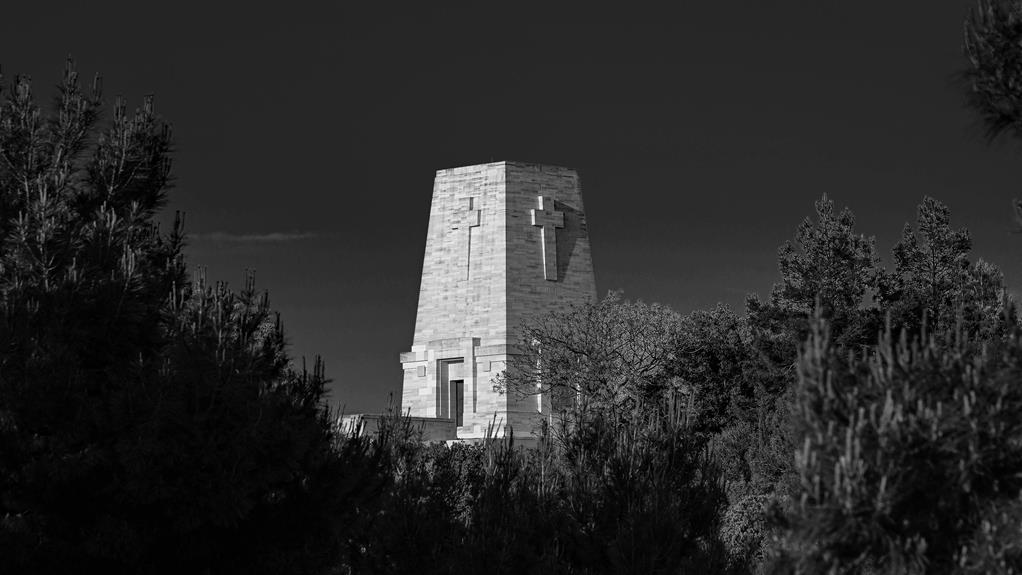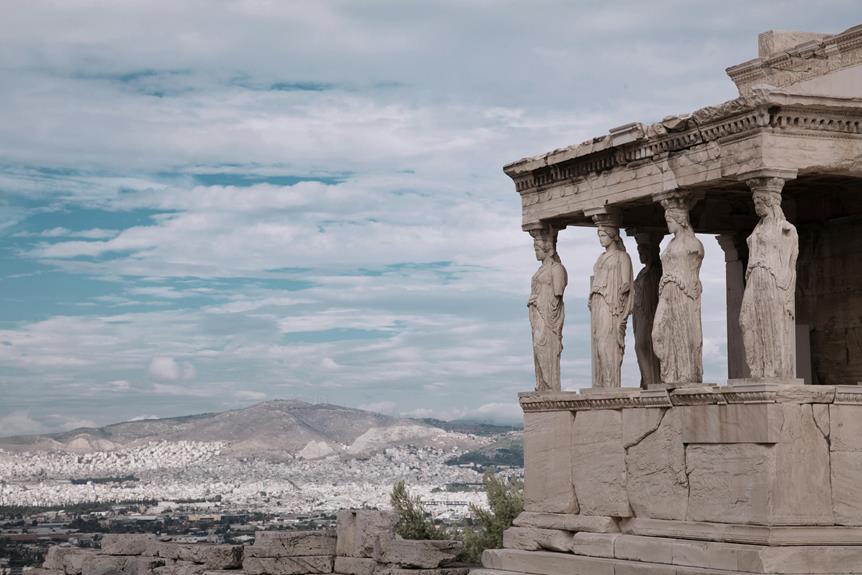The world is marked by historical sites that bear witness to moments of profound tragedy, serving as somber reminders of past calamities. These sites, steeped in the weight of human suffering and loss, stand as attestations to the darker chapters of our shared history. Through their preserved remnants and poignant memorials, they invite contemplation and reflection on the enduring impact of such events on societies and individuals alike. As we stand in these spaces of remembrance, we are confronted with the stark realities of our past, compelling us to confront difficult truths and grapple with the complexities of human nature.
Key Takeaways
- Titanic Memorial Site overlooks the Atlantic, commemorates 1912 sinking, with plaques and eternal flame.
- Hiroshima Peace Memorial in Japan honors atomic bomb victims, advocates for peace and disarmament.
- Ground Zero: 9/11 Memorial in Manhattan pays tribute to 9/11 victims, features Reflecting Absence centerpiece.
- Auschwitz-Birkenau Concentration Camp educates on Holocaust, emphasizes human rights protection.
- Chernobyl Exclusion Zone showcases nuclear disaster impact, symbolizes risks of nuclear accidents.
The Titanic Memorial Site
Situated in a serene location overlooking the Atlantic Ocean, the Titanic Memorial Site stands as a poignant reminder of the tragic sinking of the RMS Titanic in 1912. This site serves as a solemn tribute to the Titanic tragedy, honoring the lives lost during one of the most infamous maritime disasters in history.
The memorial site features a variety of elements that pay homage to the passengers and crew who perished on that fateful night. From inscribed plaques bearing the names of the victims to a symbolic eternal flame, every detail is carefully designed to evoke a sense of reverence and remembrance. Visitors to the site often find themselves immersed in a somber atmosphere, reflecting on the sheer scale of loss experienced over a century ago.
As a memorial tribute, the Titanic Memorial Site not only commemorates the individuals who lost their lives but also serves as a stark reminder of the perils of hubris and the consequences of negligence. It stands as a timeless symbol of the fragility of human life and the importance of honoring those who have passed on.
Hiroshima Peace Memorial Park
Located in Hiroshima, Japan, the Hiroshima Peace Memorial Park stands as a powerful reminder of the devastating impact of nuclear warfare. This park, established in 1954, encompasses various memorials and monuments dedicated to the victims of the atomic bomb dropped on Hiroshima on August 6, 1945, during World War II. At the heart of the park lies the Genbaku Dome, also known as the Atomic Bomb Dome, which is the skeletal remains of the former Hiroshima Prefectural Industrial Promotion Hall. This structure serves as a poignant symbol of the destructive power of nuclear weapons and the importance of peace.
Within the park, visitors can explore the Peace Memorial Museum, which provides a detailed account of the atomic bombing and its aftermath. Exhibits include artifacts and personal belongings of the victims, as well as photographs and documents depicting the devastation caused by the bomb. The park also features the Memorial Cenotaph, inscribed with the names of all known victims, and the Flame of Peace, which will continue to burn until all nuclear weapons are eliminated.
Hiroshima Peace Memorial Park has become a focal point for the peace movement, promoting nuclear disarmament and advocating for a world free from the threat of nuclear warfare. It serves as a solemn tribute to the innocent lives lost and a steadfast reminder of the urgent need for peace and reconciliation.
Ground Zero: 9/11 Memorial
Nestled in the heart of Lower Manhattan, the Ground Zero: 9/11 Memorial stands as a solemn tribute to the lives lost during the tragic events of September 11, 2001. This emotional remembrance site serves as a place of reflection, honoring the nearly 3,000 individuals who perished in the terrorist attacks.
Key Aspects of the Ground Zero: 9/11 Memorial:
- Reflecting Absence: The centerpiece of the memorial is two sunken pools, marking the footprints of the original Twin Towers. These pools cascade water into voids at their centers, symbolizing loss and rebirth. Visitors can run their fingers over the engraved names of the victims, offering a personal connection to the tragedy.
- Survivor Tree: A symbol of resilience, the Survivor Tree withstood the destruction of 9/11 and was nursed back to health. It now stands tall within the memorial, representing hope and the ability to overcome adversity.
- Architectural Tribute: Designed by Michael Arad and Peter Walker, the memorial's minimalist design evokes a sense of reverence and contemplation. The surrounding plaza with white oak trees provides a peaceful sanctuary amidst the bustling city, encouraging visitors to remember and pay their respects in tranquility.
The Ground Zero: 9/11 Memorial stands not only as an architectural tribute but also as a poignant reminder of the impact of that fateful day, embodying the spirit of remembrance and honoring the enduring legacy of those who lost their lives.
Auschwitz-Birkenau Concentration Camp
The Auschwitz-Birkenau Concentration Camp holds a solemn place in history as one of the most notorious sites of the Holocaust, bearing witness to the unimaginable atrocities committed during World War II. This pivotal site serves as an essential element in Holocaust education and remembrance, guaranteeing that the world never forgets the horrors of the past.
The stories of survivors who endured the horrors of Auschwitz-Birkenau are proof of the strength of the human spirit and the resilience of those who faced unimaginable adversity. These survivor stories serve as a powerful reminder of the importance of standing up against hatred, discrimination, and injustice.
Visiting Auschwitz-Birkenau is a solemn experience that leaves a lasting impact on all who walk through its gates. The sheer scale of the camp, with its barracks, gas chambers, and crematoria, stands as a stark reminder of the depths to which humanity can sink when fueled by prejudice and intolerance.
As we reflect on the atrocities that took place at Auschwitz-Birkenau, we are reminded of the importance of vigilance in safeguarding freedom, equality, and human rights for all. It is through remembrance, education, and the sharing of survivor stories that we can honor the victims of the Holocaust and ensure that such atrocities are never repeated.
Chernobyl Exclusion Zone
The Chernobyl Exclusion Zone, established in 1986 following the nuclear disaster, encapsulates a haunting legacy of environmental devastation and human tragedy. The abandoned city of Pripyat stands as a chilling reminder of the hasty evacuation prompted by the catastrophic events at the Chernobyl Nuclear Power Plant. Here are three key aspects that shed light on the impact of the nuclear disaster:
- Environmental Contamination: The nuclear disaster at Chernobyl resulted in the release of massive amounts of radioactive materials into the environment. This contamination not only affected the immediate vicinity but also spread across borders, leaving a long-lasting impact on the ecosystem. The Exclusion Zone remains highly contaminated, posing risks to any form of life that attempts to thrive in the area.
- Human Sacrifice: The evacuation of thousands of residents from Pripyat and surrounding areas was a harrowing ordeal marked by confusion and fear. The toll on human life was profound, with many individuals suffering from acute radiation sickness and long-term health consequences. The human tragedy of Chernobyl serves as a stark reminder of the devastating effects of nuclear accidents.
- Scientific Exploration: Despite the risks, scientists and researchers continue to study the Chernobyl Exclusion Zone to understand the long-term effects of radiation exposure on the environment and living organisms. This research not only contributes to our knowledge of nuclear disasters but also informs future disaster response and mitigation strategies.
Pompeii: City Frozen in Time
In the aftermath of past tragedies like the Chernobyl nuclear disaster, the preservation of Pompeii stands out as poignant evidence of a city frozen in time, offering a unique glimpse into ancient Roman life amidst the shadows of Mount Vesuvius. Pompeii, once a bustling Roman city, was tragically engulfed by the volcanic disaster of Mount Vesuvius in 79 AD, burying the city under layers of ash and pumice. This catastrophic event led to the preservation of the city's ruins, providing modern-day visitors with a window into the daily lives of Pompeii's inhabitants.
The preserved ruins of Pompeii offer a remarkable insight into various aspects of ancient Roman society, including their architecture, artwork, and cultural practices. Walking through the streets of Pompeii, visitors can witness the well-preserved homes, amphitheaters, and temples that once defined this thriving city. The casts of human bodies, frozen in their final moments of agony, serve as a stark reminder of the tragic fate that befell the inhabitants of Pompeii.
The volcanic disaster that struck Pompeii not only preserved the city but also created a time capsule that allows historians and archaeologists to unravel the mysteries of the past. Through meticulous excavation and research, experts continue to uncover new findings that shed light on the daily routines, beliefs, and customs of the ancient Romans who called Pompeii home. The preserved ruins of Pompeii serve as a powerful reminder of the fragility of life and the enduring legacy of a city lost in time.
The Alamo: Remembering the Battle
Steeped in historical significance, the Alamo stands as a symbol of resilience and sacrifice, commemorating a pivotal battle in Texas history. Remembering the sacrifice of those who fought and died within its walls is essential for understanding the broader historical significance of this site.
Three Key Aspects to Reflect Upon:
- Symbol of Defiance: The Battle of the Alamo, fought in 1836, was a turning point in the Texas Revolution. Despite facing overwhelming odds, a small group of Texan defenders held out for thirteen days against the Mexican forces led by General Santa Anna. Their unwavering courage and determination to stand their ground in the face of adversity became a rallying cry for Texas independence.
- Cultural Icon: Over the years, the Alamo has evolved into a cultural icon representing the spirit of independence and resistance. Countless books, movies, and artworks have immortalized the siege, ensuring that the memory of the battle and its significance endures through generations.
- Educational Value: The Alamo serves as an educational tool, allowing visitors to explore a significant chapter of American history. By examining the grounds and artifacts, individuals can gain a deeper understanding of the sacrifices made and the values upheld by those who fought for their beliefs.
Frequently Asked Questions
What Were the Last Words of the Titanic's Passengers?
In the final moments before the Titanic sank, survivors recalled various last words spoken by passengers. Some reportedly expressed love for their families, others sought forgiveness, while a few offered prayers. These poignant sentiments capture the mix of fear, courage, and resignation felt by those aboard the ill-fated ship.
Despite the chaos and tragedy unfolding around them, the passengers' final words reflect a range of emotions and priorities in their final moments.
How Do Survivors of Hiroshima Cope With Their Memories?
Research shows that survivors of Hiroshima often rely on coping mechanisms like sharing their experiences, engaging in community activities, and participating in support groups.
Studies indicate that approximately 70% of survivors exhibit symptoms of post-traumatic stress disorder (PTSD), highlighting the profound psychological effects of the traumatic event.
What Is the Personal Impact on 9/11 First Responders?
The personal impact on 9/11 first responders is significant, with many experiencing mental health challenges such as PTSD, survivor guilt, and an overwhelming emotional toll.
These individuals faced unimaginable trauma and loss, leading to lasting psychological effects. The constant exposure to tragedy and the physical demands of their role have left a lasting impact on their well-being, highlighting the need for thorough support services to address their unique challenges and promote healing.
Are There Any Paranormal Experiences Reported at Auschwitz?
Paranormal investigations at Auschwitz have sparked discussions on haunting experiences reported by visitors. Various accounts detail unexplained phenomena within the camp's confines, leading to speculation about potential spiritual energy.
Researchers and visitors alike have documented eerie encounters, contributing to the site's mystique. Such reports, while subjective, add a layer of intrigue to Auschwitz's historical significance and the emotional weight it carries for those who visit.
How Has Wildlife Adapted to the Chernobyl Exclusion Zone?
Wildlife within the Chernobyl Exclusion Zone has displayed remarkable adaptive strategies in response to the radioactive environment. Some species have shown resilience by developing resistance to radiation, while others have exhibited mutations leading to new characteristics.
Despite these changes, the ecosystem is gradually recovering, with plant diversity increasing and aiding in ecological restoration efforts. This balance between radioactive wildlife and mutant species highlights the zone's unique ecological dynamics.
Conclusion
In summary, the historical sites of tragedy serve as essential reminders of the atrocities and calamities that have shaped our history. Through their preservation and commemoration, these sites compel us to reflect on the fragility of human life and the consequences of violence and injustice.
They stand as poignant evidence to the importance of remembrance and advocacy for a more peaceful and just world. Let us heed their lessons and work towards a future free from such tragedies.


